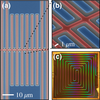The Quantum Electronics Group (QEG) has two core objectives: (1) to perform fundamental research that enables the detection of weak signals based on quantum coherence and quantum entanglement in superconducting quantum systems, (2) to develop low noise, high bandwidth multiplexed readout for arrays of cryogenic and quantum sensors.
The first core objective leverages the groups existing expertise in superconducting materials, superconducting device design, quantum-limited parametric amplifiers, and cryogenics to explore the detection of weak signals using superconducting devices and for studying loss mechanisms in superconducting devices relevant for quantum information. This work includes the Boulder Cryogenic Quantum Testbed (BCQT) Project which develops and openly disseminates standard protocols to reproducibly measure the performance characteristics of superconducting microwave resonators used in quantum computing circuits, especially at millikelvin temperatures and single photon powers.
The second core objective, developing readout for arrays of cryogenic and quantum sensors, focuses on the design of low-noise amplifiers and multiplexing circuits that are optimized for sensors produced both within the Quantum Sensors Division and the larger community using low-temperature detectors. To support the widest adoption of this novel sensor technology, the QEG also designs and builds the custom room-temperature electronics necessary to perform end-to-end readout with these systems.
Projects and Programs
Publications
Awards
Contacts
Group Leader
-
(303) 497-5895




